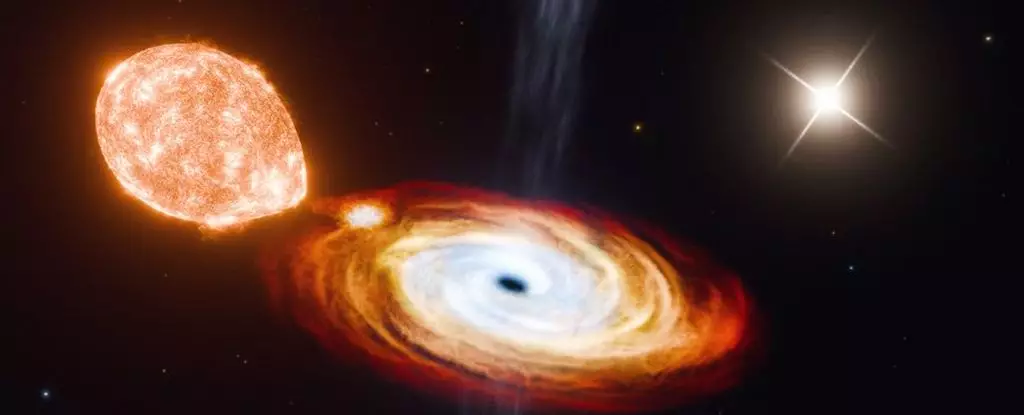In the vast expanse of our universe, nestled within the constellation of Cygnus, a remarkable astronomical phenomenon unfolds 7,800 light-years from our terrestrial home. Known as V404 Cygni, this system features a black hole engaged in a captivating dance with its celestial companions. Recent investigations have unveiled an extraordinary twist in this cosmic narrative: the presence of a secondary companion star that orbits the central black hole over a strikingly long period of approximately 70,000 years. This intriguing discovery not only enhances our understanding of V404 Cygni but also challenges our preexisting notions about black hole formation and the dynamics of such celestial systems.
V404 Cygni is unique in that it already contains a close companion star, which orbits the black hole every 6.5 days, feeding it in a captivating display of cosmic interaction. With the recent inclusion of a third companion on a much wider orbit, V404 Cygni transforms into an unprecedented trinary system. This complexity is significant because it opens new avenues for scientific investigation and inquiry into how black holes might evolve and develop.
Scientific consensus has long held that black holes are predominantly formed through the explosive deaths of massive stars—events known as supernovae. However, the latest findings surrounding V404 Cygni urge scientists to reconsider this doctrine. Kevin Burdge, a physicist from the Massachusetts Institute of Technology, notes the implications of these discoveries: “This system is super exciting for black hole evolution, and it also raises questions of whether there are more triples out there.”
The European Space Agency’s Gaia mission played a pivotal role in this revelation by meticulously mapping the three-dimensional positions and movements of stars within our Milky Way galaxy. For years, astronomers believed the secondary star was merely an unrelated celestial body nearby. However, the Gaia data unveiled a compelling connection: both stars are moving through space together, suggesting a gravitational bond that could not have been mere coincidence. Burdge emphasized this point, explaining, “We’re seeing two stars that are following each other because they’re attached by this weak string of gravity. So this has to be a triple system.”
The implications of this finding are profound. It not only enhances our understanding of V404 Cygni but also encourages us to examine the potential existence of other trinary star systems in the universe. If such systems are common, they may provide significant insights into long-held questions regarding the formation pathways of black holes.
The conventional model for black hole formation prominently features supernova events, where a star’s core collapses into a black hole after an explosive death. While this model has significant observational support, the newly discovered dynamics of V404 Cygni suggest a compelling alternative: the direct collapse mechanism. This scenario posits that a massive star may collapse directly into a black hole without the violent ejection of material characteristic of supernova events.
Burdge and his research team conducted extensive simulations to explore the mechanics of V404 Cygni’s formation. Their findings indicate that the trinary system likely existed prior to the formation of the black hole. The simulations suggest that the gravitational bonds among the objects must have been established early on, allowing the black hole to form through direct collapse rather than as a result of a disruptive supernova.
The exploration of V404 Cygni holds immense promise for advancing our understanding of black hole evolution. The existence of trinary systems where a black hole is a member diverges from traditional binary star systems, which are well-studied yet limited in perspective on cosmic evolution. Kareem El-Badry from Caltech aptly articulates this potential, stating, “If they are common, that might solve some of the long-standing questions about how black hole binaries form. Triples open up evolutionary pathways that are not possible for pure binaries.”
The nature of these pathways may mimic vast networks of interconnected stars, complicating our understanding of black holes within their galactic communities. V404 Cygni serves as a bellwether for future research, igniting curiosity about whether similar trinary systems exist and how they might reshape scientific paradigms regarding black hole formation.
In essence, the enigmatic V404 Cygni stands as a gateway to untold revelations about black holes and their genesis. It challenges conventional wisdom while inviting further investigation into the mechanics of cosmic evolution. As astronomers continue to unveil the mysteries of our universe, discoveries like that of V404 Cygni remind us of the complexity and interconnectedness of celestial phenomena, urging us to expand our horizons in astrophysical inquiry. The quest to comprehend black holes in their myriad forms is just beginning, and systems like V404 Cygni will undoubtedly serve as harbingers of remarkable scientific advancements in the years to come.


Leave a Reply